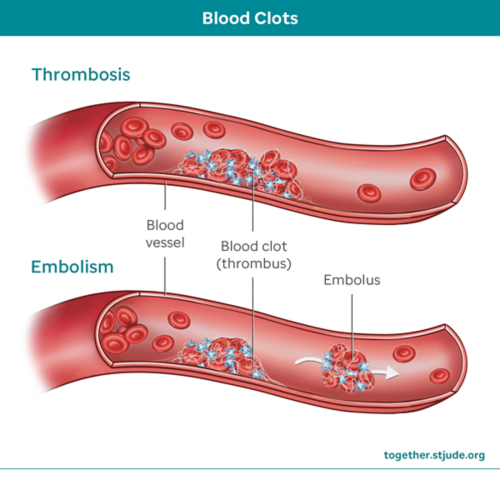Signs and symptoms of a blood clot depend on the location of the clot.
Deep vein thrombosis or DVT: If the blood clot is deep inside a muscle, usually a leg or an arm, signs and symptoms may include:
- Pain or tenderness
- Swelling
- Warmth
- Redness or discoloration of the skin
Pulmonary embolism: If the blood clot travels to the lungs, signs and symptoms may include:
- Chest pain
- Shortness of breath or difficulty breathing
- Rapid heartbeat or heart racing
- Unexplained cough or coughing up blood
Stroke: If the blood clot travels to the brain, signs and symptoms may include:
- One-sided numbness or weakness in the face, arms, or legs
- Sudden, strong headache
- Dizziness or balance problems
- Vision changes
- Trouble speaking
A blood clot is a medical emergency. Seek medical help right away if your child has any of these signs or symptoms.
Certain factors can increase your child’s risk of a blood clot. These include:
- Recent surgery or injury
- Long periods of inactivity or bedrest
- Having a central venous catheter (central line)
- Certain illnesses, such as chronic inflammatory diseases, cancer, blood disorders, or clotting disorders
- Medicines such as hormone therapy or birth control pills
- Obesity
- Smoking
- Family history of blood clots
- Inherited disorders that cause blood clots
Blood clots are diagnosed using a medical history, physical exam, blood tests, and imaging tests.
The treatment for a blood clot is based on your child’s medical history, location of the blood clot, and the cause of the blood clot.
Medicines called anticoagulants (blood thinners) are a main treatment for blood clots. In some cases, surgery may be needed to remove the blood clot if it is life-threatening.
Your child may need additional imaging tests to monitor the blood clot.
Post-thrombotic syndrome (PTS)
Post-thrombotic syndrome (PTS) is a potential long-term complication following a deep vein thrombosis. If there is damage to the blood vessel, your child can develop pain and swelling in the affected extremity (arm or leg).
Signs and symptoms of post-thrombotic syndrome may include:
- Pain
- Swelling
- Itching
- Skin discoloration
In the severe form, post-thrombotic syndrome can cause sores or ulcers on the skin. These can be hard to heal.
These signs and symptoms can also be like those of thrombosis. Seek medical care if the symptoms persist, get worse, or if you are unsure of the cause.
Ways to help manage post-thrombotic syndrome include:
- Treat the blood clot with anticoagulant medicine as prescribed
- Wear compression stockings if recommended
- Be physically active
- Elevate the affected extremity above the heart for 20–30 minutes per day if swelling develops.
Talk to your care team about your child’s risk for blood clots and the signs and symptoms to watch for. Always follow the instructions given by your care team to prevent and manage blood clots.
Questions to ask the care team
—
Reviewed: December 2024




